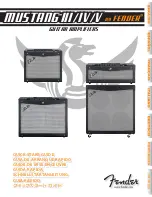
UAM4SYS
•
16
2. Install R23, another 10K ohm resistor (marked Brown, Black, Orange).
3. Install R1, yet another 10K ohm resistor (marked Brown, Black,
Orange).
4. Install R24, the last 10K ohm resistor (marked Brown, Black, Orange).
5. Install R11, a 470K ohm resistor (marked Yellow, Violet, Yellow).
6. Install R14, the last 470K ohm resistor (marked Yellow, Violet, Yellow).
7. Install U1, the LMC660AIN quad operational amplifier IC (marked
LMC660AIN). Before soldering make absolutely sure that you have
installed all 14 pins through the appropriate holes. Verify that the notch or
dot indicating pin one is facing the same direction shown in the parts
layout diagram or the circuit board’s silk screen. Solder two pins in
opposite corners of the IC. Make sure the IC is flat and square to the
board. If not, reheat one pin at a time to properly seat the IC. Now solder
the rest of the pins. Check for any possible solder bridges when you’re
done.
8. Install C47, a 0.1uF ceramic capacitor (marked 104). Ceramic
capacitors are like resistors they have no polarity so they can be installed
in either direction.
9. Install C12, a 10uF electrolytic capacitor (marked 10uF). This is the
first electrolytic capacitor you are about to install. Pay close attention to
the polarity markings on this part and all subsequent electrolytic
capacitors. In most cases the negative (-) side is marked on the capacitor,
while the positive side (+) is marked on the parts layout. If you fail to
mount this component correctly, the part can fail as well as prevent proper
operation of your project. Maker sure you install the (+) lead of the
capacitor in the (+) lead of the board. We will be installing many more of
these later in the project so be sure and remember this!
10. Install C11, another 10uF electrolytic capacitor (marked 10uF).
Watch that polarity!
11. Install C10, another 10uF electrolytic capacitor (marked 10uF).
Polarity check!
12. Install C5, yet another 10uF electrolytic capacitor (marked 10uF).
Four in a row, I probably don’t have to remind you about that polarity thing
again.
13. Install J2, a 3.5mm stereo phone jack. Make sure that this jack and
all that follow in this kit sit flat and square to the board before soldering.
14. Install J4, another 3.5mm stereo phone jack.
















































